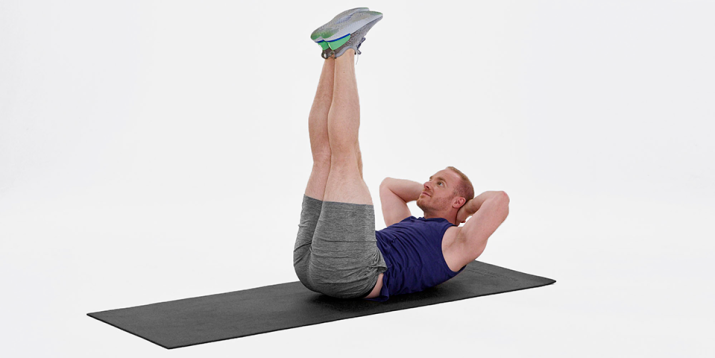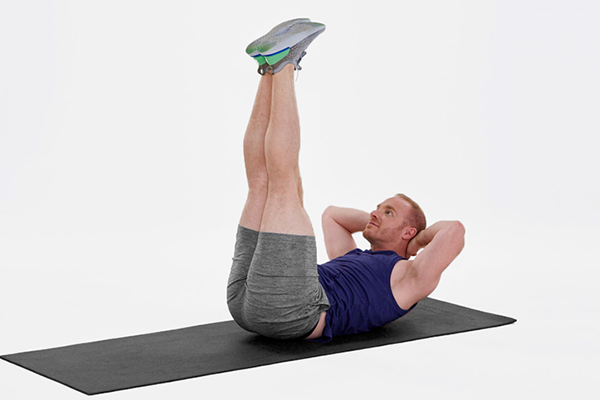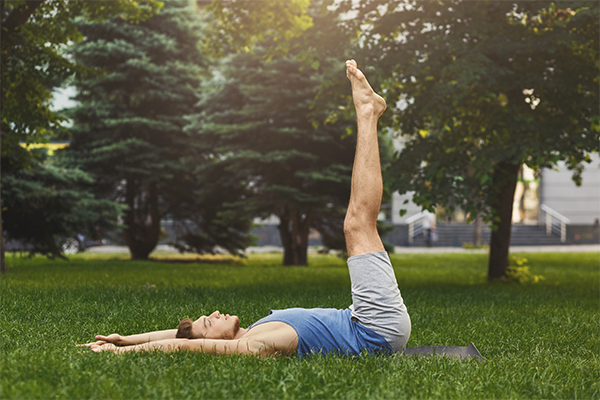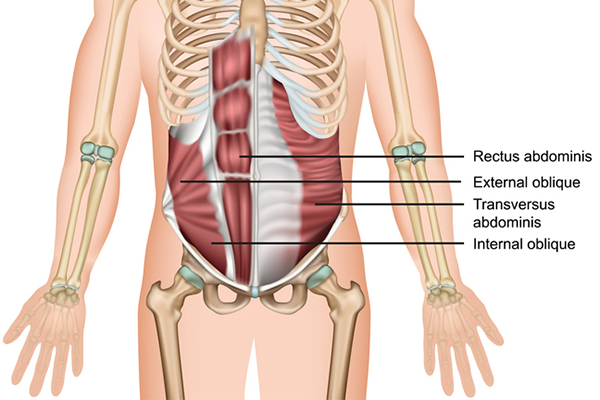How to Do Vertical Leg Crunches

If your go-to core workout includes all the same sit-ups and crunches you learned in middle school gym class, it’s probably time to shake things up.
A good option for a new ab exercise? Vertical leg crunches.
This challenging variation on the traditional crunch will elevate your abs workout by adding variety — a crucial component to any training plan.
Why is variety important? Because the body is a masterful adapter. Subject it to the same crunches exercises or ab routine day after day, and it will reach a plateau and you’ll see limited improvement.
If you want to continue to see progress (like muscle growth and strength gains) you need to vary the stimulus to the body by changing the movement, increasing the difficulty of the exercise (through variables such as tempo, rest, intensity etc.), or removing stability.
With one simple adjustment to the standard crunch, the vertical leg crunch adds in plenty of variety to keep challenging your body.
How to Do Vertical Leg Crunches With Perfect Form

- Lie on your back and raise your legs until they’re perpendicular to the floor. Keep them straight and squeezed together.
- Use your hands to support your neck by gently placing your palms on the back of your head.
- Engage your abdominal muscles and lift your shoulders and upper back off the floor. Think about lifting your chest to the sky instead of rounding your shoulders.
- Hold the crunch for one second and slowly lower the upper body to the starting position, and repeat.
How to Make Vertical Leg Crunches Harder
Breezing through your ab routine and looking for a new challenge? Try holding the abdominal contraction at the top of the movement and doing small crunches or “pulses.”
“By maintaining the contraction (as opposed to letting the back touch the floor) you get more time under tension, a proven stimulus to increase development,” says Cody Braun, CSCS.
You can also increase the difficulty of vertical leg crunches by lowering the legs from a perpendicular position to a 45-degree angle. “By lowering the legs, you are demanding more of your core to stabilize as you crunch,” Braun says.
How to Make Vertical Leg Crunches Easier
If you find that tight hamstrings make it difficult to keep your legs straight during vertical leg crunches, Braun suggests bending the knees (but still keep them pressed together).
You can also regress the vertical leg crunch to a standard crunch by placing the feet on the floor.
This variation offers more stability and allows you to gradually build strength in your core muscles.
Bonus Tips for Doing Vertical Leg Crunches

It’s not uncommon for people to rock back and forth as they do crunches, using momentum to do the exercise instead of your core muscles.
“To make the vertical leg crunch effective, you want to actively press your low back into the ground while you raise up in the crunch as well as the descent,” Braun says.
This will make the exercise harder, but doing it with the proper form will help you get all the benefits from it.
Benefits of Vertical Leg Crunches
Six-pack aspirations aside, vertical leg crunches help strengthen the ab muscles, which are integral to everything from walking and standing to lifting weights and playing sports.
“Vertical leg crunches help to strengthen the rectus abdominis, which is one of the major muscles that helps stabilize your spine,” says Braun.
Additionally, because of the positioning of the legs, the vertical leg crunch is more challenging than standard crunches.
“When you elevate the legs, you reduce the amount of contact points with the ground, which reduces stability,” explains Braun.
The less stability, the greater the potential for core muscle activation.
Muscles Targeted by Vertical Leg Crunches

Like all crunches exercises, this move targets the rectus abdominis. But, by raising the legs to a vertical position, you also engage the hip flexors.
Rectus abdominis
The rectus abdominis, the muscle that run the length of the abdomen, are what give a chiseled midsection its definition.
When well-developed, the rectus abdominis pushes against connective tissue, giving the appearance of “six-pack abs.”
Originating at the pelvis and inserting at the ribs and sternum, the rectus abdominis flexes the torso and spine.
It also works in conjunction with the other core muscles to create intra-abdominal pressure — what happens when you “brace” your core.
Hip flexors
The hip flexor muscles, primarily the iliacus and the psoas, pull the thighs and the torso toward each other.
Together, these muscles are known as the iliopsoas, which originates at the pelvis and lumbar vertebrae and inserts into the femur, or upper leg bone.
